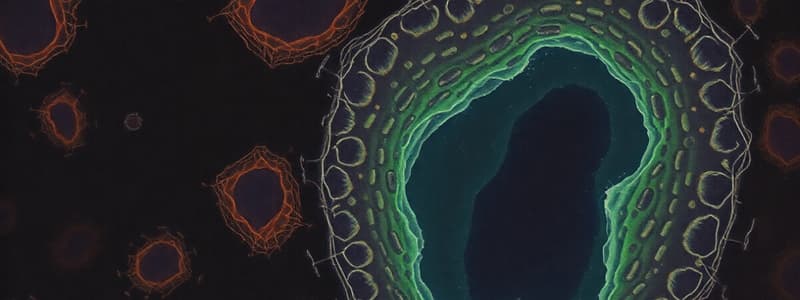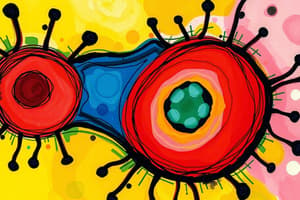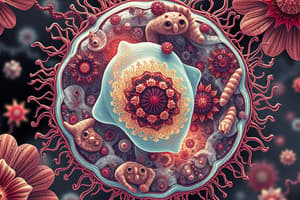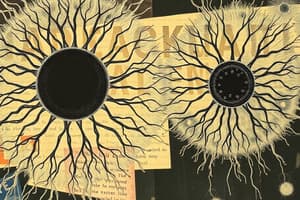Podcast
Questions and Answers
Which of the following structures are found in the respiratory system?
Which of the following structures are found in the respiratory system?
- Bronchi
- Alveoli
- Trachea
- All of the above (correct)
The lymphatic system is responsible for the production and transport of red blood cells.
The lymphatic system is responsible for the production and transport of red blood cells.
False (B)
Which of these is NOT one of the primary functions of the liver?
Which of these is NOT one of the primary functions of the liver?
- Synthesis of plasma proteins
- Detoxification of harmful substances
- Storage of glycogen
- Production of bile
- Production of insulin (correct)
The adrenal medulla is responsible for the production of the hormone cortisol.
The adrenal medulla is responsible for the production of the hormone cortisol.
The ______ is the functional unit of the kidney, responsible for filtering waste and regulating blood composition.
The ______ is the functional unit of the kidney, responsible for filtering waste and regulating blood composition.
What is the name of the connective tissue that surrounds a muscle fiber?
What is the name of the connective tissue that surrounds a muscle fiber?
The autonomic nervous system is responsible for controlling voluntary movements like walking or writing.
The autonomic nervous system is responsible for controlling voluntary movements like walking or writing.
Which of the following is a type of joint that allows only limited movement?
Which of the following is a type of joint that allows only limited movement?
What is the primary function of the cerebellum?
What is the primary function of the cerebellum?
Match the following endocrine glands with their primary hormones:
Match the following endocrine glands with their primary hormones:
Which of the following statements is TRUE about the integumentary system?
Which of the following statements is TRUE about the integumentary system?
The arrector pili muscle is responsible for causing goose bumps.
The arrector pili muscle is responsible for causing goose bumps.
What is the name of the process that leads to the formation of a gamete (sperm or egg) with half the number of chromosomes?
What is the name of the process that leads to the formation of a gamete (sperm or egg) with half the number of chromosomes?
Which of the following events occurs during the follicular phase of the menstrual cycle?
Which of the following events occurs during the follicular phase of the menstrual cycle?
Flashcards
Prokaryotes
Prokaryotes
Lack a nucleus and other membrane-bound organelles.
Eukaryotes
Eukaryotes
Have a true nucleus and other membrane-bound organelles.
Protoctista
Protoctista
A unicellular organism containing a membrane-bound nucleus. Examples include algae and protozoa.
Fungi
Fungi
Signup and view all the flashcards
Plants (Plantae)
Plants (Plantae)
Signup and view all the flashcards
Animals (Animalia)
Animals (Animalia)
Signup and view all the flashcards
Tissue
Tissue
Signup and view all the flashcards
Epithelial Tissue
Epithelial Tissue
Signup and view all the flashcards
Connective Tissue
Connective Tissue
Signup and view all the flashcards
Muscular Tissue
Muscular Tissue
Signup and view all the flashcards
Nervous Tissue
Nervous Tissue
Signup and view all the flashcards
Squamous Epithelium
Squamous Epithelium
Signup and view all the flashcards
Cuboidal Epithelium
Cuboidal Epithelium
Signup and view all the flashcards
Columnar Epithelium
Columnar Epithelium
Signup and view all the flashcards
Transitional Epithelium
Transitional Epithelium
Signup and view all the flashcards
Glandular Epithelium
Glandular Epithelium
Signup and view all the flashcards
Areolar Tissue
Areolar Tissue
Signup and view all the flashcards
Adipose Tissue
Adipose Tissue
Signup and view all the flashcards
Dense Connective Tissue
Dense Connective Tissue
Signup and view all the flashcards
Cartilage
Cartilage
Signup and view all the flashcards
Bone
Bone
Signup and view all the flashcards
Plasma
Plasma
Signup and view all the flashcards
Albumin
Albumin
Signup and view all the flashcards
Gamma Globulin
Gamma Globulin
Signup and view all the flashcards
Fibrinogen
Fibrinogen
Signup and view all the flashcards
Hemostasis
Hemostasis
Signup and view all the flashcards
Vascular Spasm
Vascular Spasm
Signup and view all the flashcards
Platelet Plug Formation
Platelet Plug Formation
Signup and view all the flashcards
Blood Coagulation
Blood Coagulation
Signup and view all the flashcards
Thrombus
Thrombus
Signup and view all the flashcards
Embolus
Embolus
Signup and view all the flashcards
Study Notes
Week 1 - Cells and Tissues
- Prokaryota lack a nucleus, organized with a membrane envelope, contain a few cell organelles, tend to be heterotrophic.
- Eukaryotes are unicellular or assemblages of similar cells, possess an organized membrane-bound nucleus (e.g. algae and protozoa).
- Fungi have protective cell walls made of chitin, are heterotrophic, have multi-nucleated hyphae, produce spores, and secrete enzymes to digest food.
- Plants (Plantae) are multicellular eukaryotes, autotrophic, with cellulose cell walls.
- Animals (Animalia) are multicellular, heterotrophic eukaryotes, further broken down by phylum (e.g. chordata – vertebrates, nematodes - worms, arthropods - insects, echinoderms - starfish, porifera - sponges).
- Cytology is the study of cells.
- Cell biology assumes that all living material consists of cells or the products of cells.
Cell Structure
- Cell surface membrane has two layers of phospholipids containing other molecules (e.g. proteins).
- It acts as a boundary between the cell and surrounding environment, controlling the movement of molecules in and out.
- Ribosomes are tiny particles made of RNA and protein, present in large numbers, either attached to the endoplasmic reticulum or free in the cytoplasm; they are the site of protein synthesis.
- Endoplasmic reticulum is a system of membrane-bound flattened sacs; rough ER has ribosomes attached, involved in protein transport; smooth ER produces lipids and steroids.
- Mitochondria have a double membrane; the inner section (the matrix) contains folds called cristae; the site of cellular respiration, converting energy into ATP (a form of chemical energy).
- Golgi apparatus is a type of endoplasmic reticulum forming membrane-bound flattened sacs, processing and modifying biochemicals.
- Lysosomes are spherical sacs surrounding digestive enzymes, involved in cell waste disposal (autophagy and autolysis).
- Microfilaments and microtubules are rod-like structures made of proteins, which provide support and aid movement.
Studying That Suits You
Use AI to generate personalized quizzes and flashcards to suit your learning preferences.




